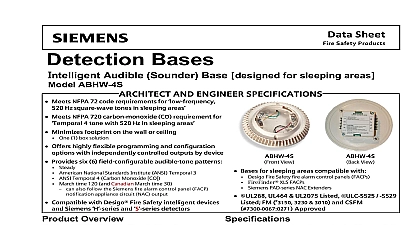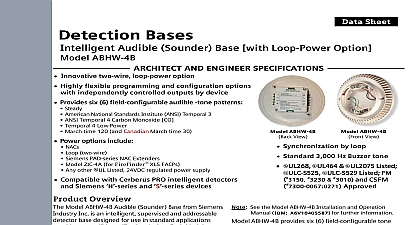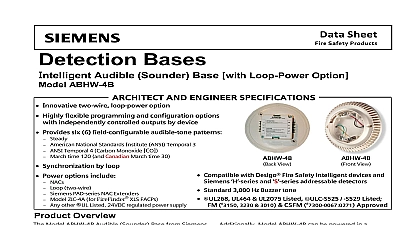Siemens ABHW-4S Cerberus PRO Audible Base (for sleeping areas), Data Sheet

File Preview
Click below to download for free
Click below to download for free
File Data
| Name | siemens-abhw-4s-cerberus-pro-audible-base-for-sleeping-areas-data-sheet-2065379418.pdf |
|---|---|
| Type | |
| Size | 1.23 MB |
| Downloads |
Text Preview
Detection Bases Intelligent Audible Sounder Base designed for sleeping areas ABHW 4S Meets NFPA 72 code requirements for Hz square wave tones in sleeping areas AND ENGINEER SPECIFICATIONS Sheet Meets NFPA 720 carbon monoxide CO requirement 4 tone with 520 Hz in sleeping areas Minimizes footprint on the wall or ceiling One 1 box solution Provides highly flexible programming and configuration with independently controlled outputs by device Supports six 6 field configurable audible tone patterns Steady American National Standards Institute ANSI Temporal 3 ANSI Temporal 4 Carbon Monoxide CO Temporal 4 Low Power March time 120 and Canadian March time 30 can also follow the Siemens fire alarm control panel FACP appliance circuit NAC output Compatible with Cerberus PRO intelligent and Siemens devices Overview Model ABHW 4S Audible Base from Siemens Industry is an intelligent supervised detector base designed for in sleeping areas of a building Each Model ABHW 4S generates a 520 Hz square wave audio signal with NFPA 72 Standard as well as UL ULC applications ABHW 4S provides six 6 field configurable tone two 2 volume levels are used with compatible detectors and FACPs Steady Temporal 3 pattern 4 pattern Temporal 4 with low power March 120 and Canadian March Time 30 are supported by intelligent audible base for sleeping areas ABHW 4S is fully compatible with all Siemens detectors listed in the detector tables included this document to the Details for Ordering section on Page 2 used in conjunction with other listed compatible fire safety components Model ABHW 4S may be in lieu of single multiple station smoke alarms to enhanced system level functionality ABHW 4S meets the requirements specified in ULC S525 ULC S529 and also UL464 including 520Hz low frequency requirements Area PRO Safety Products for infrastructure ABHW 4S View ABHW 4S View Bases for sleeping areas compatible with Cerberus PRO fire alarm control panels FACPs FireFinder XLS FACPs Siemens PAD series NAC Extenders UL268 UL464 UL2075 Listed ULC S525 Listed FM 3150 3230 3010 CSFM 7300 0067 0271 Approved ABHW 4S consists of a standard Siemens Fire Series detector base layout combined with circuitry for Cerberus PRO FACPs and Model detectors each Model ABHW 4S base houses a pre wired sounder device capable of generating a 520 Hz tone that produces a signal up to 85dBA at 10 3.1m for localized annunciation power options are available for the Model ABHW 4S base and can therefore be powered in an ordinary configuration via use of any one 1 of the notification appliance circuit NAC a Siemens NAC extender Model ZIC 4A or any UL Listed regulated power supply See the Model ABHW 4S Installation and Operation Manual A6V10405588 for further information Model ABHW 4S bases are capable of sounding individually or in any combination on the detector type and when it is used and with a compatible Siemens FACP When Model ABHW 4S bases are used with Model devices functionality is limited and is similar to Model ADBH 11 audible base Audible Base for Sleeping Areas continued ABHW 4S is a UL ULC Listed supplementary smoke device that meets or exceeds the 85dB at 10 ft 3.1m requirement specified in UL268 ULC S525 ULC as well as UL464 UL2075 including low frequency of 520Hz for Areas with s FACPs ABHW 4S functions with the following Type XLS Machine Interface PMI v10.02 or later Custom Configuration Software v10.02 or later FC901 Loop Card Model DLC v6.01 or later PRO 50 point addressable FACP 24 Software tool v01.02.16 53 v6.0.0R1 or later FC922 FC924 Data smoke detectors used with Model ABHW 4S are subject to maximum 30 ft center spacing 900 sq ft as referred to in National Fire Protection Association Standard 72 spacing however is based on ideal conditions namely ceiling no air movement and no physical obstructions the fire source and the detector aforementioned center spacing format should be referred to a guide for detector installation layout Do not mount in areas close to ventilating or air conditioning outlets joists or beamed ceilings may also effect safe spacing for detectors is mandatory for NFPA 72 guidelines and good engineering be applied to device placements spacing Data Cross Cable Properties Output Box 18 AWG Wire Gauge 2 back end blocks of up to four screw terminals on each side 120 49 95 85 dB 75 dB Temporal 3 Temporal 4 4 low power March time 120 March time 30 10.2 cm square gang box A 4 10.2 cm octagon box is not compatible with Model ABHW 4S Data continued Ratings Voltage Current power 16 33 VDC power 16 33 VDC SLC loop 250 external source 1.0 mA dBA 65 mA 33VDC dBA 90 mA 24VDC dBA 165 mA 16VDC dBA 0.85 mA from loop dBA 28 mA 33VDC dBA 33 mA 24VDC dBA 45 mA 16VDC dBA 1.6 mA from loop for Ordering S54320 F14 A1 for sleeping areas S54320 F14 A2 Sleeping Room Version 520 Hz Base COO USA Sounder Base Intelligent Detectors S54320 F8 A2 Optical Detector Heat Detector Heat Detector Heat Detector Heat w CO Detector Remote Lamps Remote Alarm Lamp Wall Remote Alarm Lamp Ceiling Model Series Detectors Optical Heat Detector Optical Detector Heat Detector Optical Heat Detector Optical Detector Heat Detector Models SFP 11 SFPO 11 and SFPT 11 detectors are approved in Canadian installations Model bases limited in audible base functionality Siemens Tech Support at 1 800 248 7976 for more details Cerberus PRO Industry Inc Building Technologies Div Fernwood Road Florham Park NJ 07932 973 593 2600 Fax 908 547 6877 www USA Siemens com Cerberus PRO Technologies Division Fire Safety in U S A The information contained in this data sheet document is intended only as a summary and is to change without notice The devices described here have specific instruction sheets cover various technical limitation and liability information of these instruction sheets and the General Product Warning and Limitations


